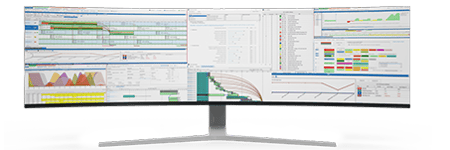Artificial Intelligence and Virtual Processes
Emerging technologies like artificial intelligence (AI) and virtual processes are redefining industry standards. For Manufacturing IT Managers, integrating AI-driven solutions into daily operations isn't just an option—it’s quickly becoming essential. This transformative shift is empowered by advanced planning and scheduling systems like PlanetTogether, especially when integrated with enterprise resource planning (ERP) systems such as SAP, Oracle, Microsoft, Kinaxis, and Aveva.
By utilizing AI and virtual processes in tandem with robust ERP-APS integrations, IT Managers can not only optimize production but also tackle complex industry challenges, from regulatory compliance to supply chain transparency.
This blog will explore the integration of PlanetTogether with major ERP platforms, highlighting the key benefits and practical applications of AI and virtual processes in medical manufacturing.

AI and Virtual Processes in Medical Manufacturing
Medical manufacturing demands precision, reliability, and strict adherence to regulatory standards. To achieve this, companies are increasingly relying on AI and virtual processes, which contribute to the following areas:
Quality Control: AI-driven algorithms analyze vast amounts of production data, identifying anomalies that might signify quality issues before they become critical.
Predictive Maintenance: AI can predict machine breakdowns or deviations, minimizing downtime and ensuring continuous production.
Enhanced Process Efficiency: Virtual processes allow teams to simulate manufacturing workflows, testing new procedures, or configurations digitally before implementing them in the physical environment.
Risk Mitigation: AI-driven insights help mitigate risks associated with production, supply chains, and compliance, allowing manufacturers to respond more agilely to unforeseen changes.
These advantages, when coupled with PlanetTogether’s APS system and major ERP platforms, enable a seamless flow of data across departments, optimizing both planning and execution.
![]()

Key Benefits of Integrating PlanetTogether with ERP Systems
An integrated planning and scheduling approach—merging the powerful functionalities of PlanetTogether with ERP systems like SAP, Oracle, Microsoft, Kinaxis, and Aveva—offers several significant benefits.
Unified Data Access and Enhanced Decision-Making
PlanetTogether’s APS software complements ERP systems by providing real-time data on production schedules, resource availability, and material usage. When integrated, this data becomes even more powerful:
Example: Integrating PlanetTogether with SAP’s advanced data processing enables quick access to production data, allowing AI algorithms to analyze it for potential efficiencies. IT Managers can then make data-driven decisions to adjust production schedules or reallocate resources in real-time.
Result: This level of visibility and data unification not only boosts efficiency but also enables fast, informed responses to production issues.
Streamlined Workflow and Improved Coordination
Medical manufacturing facilities often face challenges in synchronizing various departments and processes. With ERP-PlanetTogether integration, workflows become streamlined, leading to:
Enhanced Coordination: When a change occurs—such as a delay in raw materials—ERP systems like Oracle automatically notify PlanetTogether, which adjusts production schedules to mitigate impact.
Virtual Process Simulation: Microsoft Dynamics, when integrated with PlanetTogether, allows for virtual simulation of different workflow scenarios, testing variables and predicting potential outcomes.
Advanced Predictive Analytics for Maintenance
Predictive maintenance is a game-changer for medical manufacturers. With AI, this approach anticipates equipment issues before they escalate, preventing costly breakdowns and delays. Through PlanetTogether’s integration with ERP systems, predictive analytics become more actionable:
AI-Driven Predictive Maintenance: For example, Kinaxis' supply chain analytics capabilities can forecast machine breakdowns based on usage patterns. When connected to PlanetTogether, it automatically adjusts scheduling to accommodate preventive maintenance without impacting production.
Enhanced Resource Allocation: This integration provides managers with tools to allocate resources effectively, ensuring machines are serviced without causing production bottlenecks.
Digital Twins and Virtual Process Modeling
Digital twins, a virtual replica of a physical asset, are becoming increasingly popular in manufacturing. By integrating PlanetTogether with ERP systems like Aveva, digital twins of the production line can be created and monitored in real-time, leading to the following benefits:
Testing and Troubleshooting: New production setups or maintenance schedules can be virtually tested using PlanetTogether-Aveva integrations, identifying issues before they affect real-world operations.
Real-Time Process Monitoring: Changes in the production environment are reflected in the digital twin, allowing managers to track operations and make adjustments as needed, which is crucial in a regulated industry where even small discrepancies can have significant impacts.

Practical Applications of AI and Virtual Processes in Medical Manufacturing
Integrating AI and virtual processes offers specific applications within medical manufacturing, enhancing production efficiency and compliance.
Automating Compliance and Documentation
The medical industry is heavily regulated, and manufacturing facilities are required to document every step of production for regulatory compliance. AI systems, through integration with ERP and PlanetTogether, can automate much of this documentation, capturing data directly from production lines.
Example: An integrated SAP-PlanetTogether system can automatically log production details, reducing human error and ensuring a traceable record for each product batch.
Compliance Benefits: Automated documentation not only ensures that records are accurate but also speeds up the audit process, helping facilities meet stringent industry standards without excessive manual effort.
AI-Driven Production Optimization
AI algorithms analyze production data to determine optimal setups, resource allocation, and workflow sequences. In medical manufacturing, where precision is paramount, this ability is invaluable.
Example: An Oracle-PlanetTogether integration can use AI to determine the best order of operations for a batch of medical devices, optimizing for minimal waste and maximum efficiency. The integrated system can adjust the production sequence dynamically, responding to changes such as delays in raw material availability.
Outcome: Production becomes more agile, able to adapt to real-time changes without compromising quality or compliance.
Inventory Management and Supply Chain Transparency
A well-integrated system allows for predictive inventory management, ensuring that necessary components are available when needed and reducing excess inventory that ties up capital.
Example: By integrating Kinaxis with PlanetTogether, manufacturers can gain visibility into their supply chain and production schedules, predicting inventory needs and proactively managing supply chain disruptions.
Outcome: This integration minimizes delays in production due to inventory shortages, which is critical in medical manufacturing, where delays can disrupt the supply of essential medical devices or pharmaceuticals.
Optimized Production Schedules and Reduced Lead Times
By leveraging the data-driven scheduling capabilities of PlanetTogether, IT Managers can create optimized production schedules that maximize throughput while minimizing lead times.
Example: With Microsoft Dynamics integrated with PlanetTogether, facilities can simulate different production scenarios, choosing the one that minimizes downtime and lead times. In a scenario where a particular machine is needed for multiple product lines, AI can analyze and optimize its usage.
Outcome: Facilities meet tight deadlines, reduce production bottlenecks, and improve on-time delivery, all while maintaining high-quality standards.
Overcoming Implementation Challenges
Implementing AI and virtual processes in a highly regulated industry comes with its own set of challenges, particularly in integration and data management. However, by working closely with ERP and APS solution providers, these challenges can be mitigated.
Data Security: Ensuring that sensitive production data is securely managed and stored is crucial. IT Managers should work with PlanetTogether and ERP vendors to establish robust data encryption and access controls.
Scalability: As production demands grow, integrated systems should be able to scale without compromising performance. Choosing flexible solutions, like PlanetTogether integrated with Kinaxis or Oracle, ensures that the system can handle increased production volume.
User Training: Successful implementation relies on user adoption. Providing training for team members on AI-driven systems and virtual processes ensures that employees can leverage these tools effectively.
The integration of PlanetTogether with ERP systems such as SAP, Oracle, Microsoft, Kinaxis, and Aveva is revolutionizing medical manufacturing. For IT Managers, this powerful synergy of AI and virtual processes translates into optimized production, enhanced compliance, and more robust decision-making capabilities. As medical manufacturing continues to evolve, adopting these innovations is no longer a competitive advantage—it’s an industry necessity.
Embracing AI-driven solutions and virtual process modeling today will lay the groundwork for future-ready manufacturing facilities, poised to meet the demands of tomorrow’s healthcare industry.
Are you ready to take your manufacturing operations to the next level? Contact us today to learn more about how PlanetTogether can help you achieve your goals and drive success in your industry.
Topics: PlanetTogether Software, Integrating PlanetTogether, Medical Manufacturing, Unified Data Access and Enhanced Decision-Making, Advanced Predictive Analytics for Maintenance, Streamlined Workflow and Improved Coordination, Digital Twins and Virtual Process Modeling




















LEAVE A COMMENT